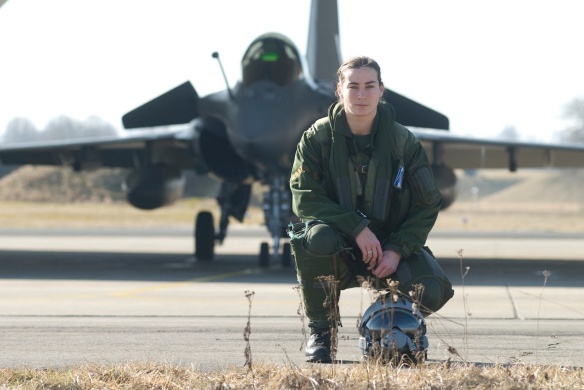The very first female Rafale pilot, Captain Claire Merouze, 26, is assigned to the 01.007 Provence squadron and already has logged 5 flights with instructors on Rafale B.
Despite the poor state of the French Air Force at the end of World War II, it was to play a significant role in the Indochina War (1945-1954), the Algerian War (1954-1962), and the Suez Crisis (October-November 1956). Most important, after France successfully tested its first atomic bomb on 13 September 1960, the air force began exercising a nuclear deterrence role. French aircraft by the 1960s were regarded as some of the world’s most advanced, a legacy of substantial military spending during the early Cold War years.
At the end of World War II, France had to reconstruct its entire military, including the air force. During the war the air force, consisting of approximately 145,000 personnel, had been attached to American, British, and Soviet flying units. There had been only one large French air unit, the First Air Division, which at the end of the war was stationed in Germany. Upon liberation, the French government began the task of revamping its air force by ordering more than 6,000 new aircraft, including light planes (primarily Moranes), light twin-engine planes (including NC 701s, SO 91s, and C499s), transport planes (primarily Bloch 161s and Ju-52s), and warplanes (VB 10s, B1 175s, and MS 472s). By the close of 1945, some 900 new planes had been delivered. These aircraft helped equip a force that during the latter part of the war was flying aircraft provided by its allies and making use of captured German planes. Air force personnel were initially cut to below 60,000, but beginning in 1952 those numbers significantly rose.
Although French Air Force officers felt vindicated by the importance of airpower in World War II, there was no unanimity on the future role of airpower, and many military leaders continued to view the air force as auxiliary and subservient to land forces. Much of this debate on the role of the air force became moot with the formation of the North Atlantic Treaty Organization (NATO) in 1949, which obligated France to assign two wings of its air force to the Western alliance.
France began the Indochina War with a modest air element of a dozen ex-RAF Spitfire and some ex-Japanese Oscar III fighters, eighteen U. S.-built C-47 transports, and four U. S.-built PBY patrol bombers. Junkers Ju-52s, Siebels, and Martinets were soon added to the inventory, which grew throughout the conflict. By 1948, France had committed about 10 percent of its total aircraft to the conflict. In late 1949, the United States provided P-63 King Cobra, F6F Hellcats, and F8Fs Bearcat fighters as well as B-26 Invader bombers, the latter the first purpose-built bomber used in the war. The air force made an important contribution to the war, primarily in providing aerial transport to remote areas, including both parachute and resupply operations. Because of the difficult mountain and jungle terrain, the air force also acted as flying artillery. In 1950, the French began using helicopters in the war; Hiller UH-12As, H-23As, H-23Bs, and Sikorsky S-51s and S55s proved highly effective in troop transport and medical evacuations. The French fleet of forty-two helicopters evacuated 10,000 people and rescued 38 downed pilots.
In both the Algerian War and the Suez Crisis, the French made extensive use of aircraft. In the Algerian War, the French relied on 700 American T-6 Texans, but these aircraft proved vulnerable to ground fire and were later replaced with armored planes, including A-1 Skyraiders. Helicopters (Bell 47s, H-19s, and H-34s) flew highly effective troop transport, medical evacuation, reconnaissance, and close-air-support missions. The French also employed their new U. S.-built F-100 Super Sabre attack aircraft in Algeria.
In the 1956 Suez operation, the French employed U. S.-built F-84F Thunderjets, some of which were flown out of Cyprus and Malta. These destroyed much of the Egyptian bomber force based at Luxor. Nord 2501s dropped French paratroopers in two airborne assaults on 5 October. Also, during the last week of October the French turned over to Israel eighteen F-84Fs and some Noratlases to buttress that country’s air defense.
A new era began in the late 1950s when Charles de Gaulle questioned American resolve to use its nuclear weapons in the event of a Soviet attack against Western Europe. France withdrew from the NATO military command structure and developed its own nuclear strike force, the Force de Frappe. From 1964 to 1974, three wings of Dassault Mirage IV supersonic bombers, based in nine different locations, provided the delivery capability for France’s 70-kiloton free-fall nuclear bombs. By the mid-1970s, with the advent of missile delivery systems with 150-kiloton nuclear warheads, the French bomber force was reduced in number. Intermediate-range S-2 ballistic missiles, with a range of up to 2,000 miles, were housed in underground silos at Saint Christol. Beginning in May 1980, the S-2s were replaced with S-3s capable of carrying a 1.2-megaton thermonuclear warhead.
By 1990, with 93,100 active personnel and more than 500 combat aircraft in service, France’s Air Force provided a strong air defense. Although its participation was limited, French airpower deployed in the Persian Gulf War was the third largest. But it was its strategic forces of 18,710 personnel maintaining a modest nuclear arsenal that constituted France’s most significant contribution to the Cold War.
References Armitage, M. J., and R. A. Mason. Air Power in the Nuclear Age. Urbana: University of Illinois Press, 1983. Chritienne, Charles, and Pierre Lissarague. A History of French Military Aviation. Translated by Francis Kianka. Washington, DC: Smithsonian Institute Press, 1986. Hecht, Gabrielle. The Radiance of France: Nuclear Power and National Identity after World War II. Cambridge, MA: MIT Press, 1998. Higham, Robin. 100 Years of Air Power and Aviation. College Station: Texas A&M University Press, 2003.
